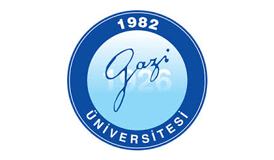Research Article
Super Volcano Activity (Yellowstone and Elbrus): Parameters of Sensitivity
Department of Physics, Russian Academy of Sciences, Russia
*Corresponding author: Oleg Borisovich Khavroshkin, Professor, Department of Physics, Russian Academy of Sciences, Russia, E-Mail: khavole@ifz.ru
Received: October 18, 2019 Accepted: October 31, 2019 Published: November 8, 2019
Citation: Khavroshkin OB, Tsyplakov VV. Super Volcano Activity (Yellowstone and Elbrus): Parameters of Sensitivity. Int J Phys Stud Res. 2019; 2(1): 71-77. doi: 10.18689/ijpsr-1000110
Copyright: © 2019 The Author(s). This work is licensed under a Creative Commons Attribution 4.0 International License, which permits unrestricted use, distribution, and reproduction in any medium, provided the original work is properly cited.
Abstract
The commonality of cyclic processes and rhythms of super volcanoes with periodic components of solar neutrino and muons fluxes is a subject of modern research. This study includes new additional factors - solar flares and thermal fields of radioactive structures. Experimental basis of research - simultaneous observations of temperature in the creek of the Yellowstone volcano caldera and in the laboratory of the Institute of Physics of the Russian Academy of Sciences on cesium and uranium ore 235. There is a shift of the maximum correlation by 36.5 days relative to variations in the temperature of cesium 137. That is, the flux of solar neutrinos and muons almost simultaneously affect cesium 137 and the radioactive substances of the magma chambers of the super volcano, but thermal variations of magma and surrounding structures reach the surface of the day and the sources of the stream in only 36.5 days. The study of the fine structure of temperature fields in the thickness of the Elbrus rocks as a super volcano was carried out with precision thermometers that allow temperature measurements with a sensitivity of ~0.005°C in the gallery of the North Caucasus Geophysical Observatory of the Physical Institute of Physics, Russian Academy of Sciences, that is, in the Baksan Gorge at a distance of 4100 m from the mouth of the Baksan Neutrino Division of the neutrino system. The inter correlation function between the radioactivity variations of uranium ore in the laboratory of the Institute of Physical Problems of the Russian Academy of Sciences with hourly averaging and variations in the temperature of a radioactive source during hourly averaging strongly correlate, that is, a forecast of the activation of volcanism by the level of radiation from a laboratory source is possible. On the other hand, one can point to the general sensitivity parameters of volcanoes: temperature fields, interaction with the neutrino solar flux, solar flares, and the level of radioactivity of the volcanic zone.
Keywords: Solar Neutrino Fluxes; Muons; Igneous Chambers and Laboratory Radioisotopes; Synchronization of Radioactive Processes; Temperature Fields.
Introduction
The thermal fields of super volcanoes and the temperature fields of radioactive substances have common significant rhythms, determined by the cyclical nature of solar processes and, accordingly, the latent periodicity of neutrino solar fluxes. Temperature variations of all types are determined by anomalous neutrino radio-isotopic (ANRI) absorption or the effect of the interaction of the neutrino flux with the radioactive structures of the Earth [1,2]. At depths of ~40 m, a thermal component can exist due to muons (see Кр-index), and at any and greater depths-heat from the interaction of the solar neutrino flux with radioactive structures. The radiation component of laboratory-type sources is usually monitored by a radiometer or the more modern method-an accurate thermometer. The most important task of the study is to find reliable parameters characterizing the growth of volcano activity. Such parameters should control the growth of the volcano temperature, seismic activity, the cosmogonic factor-the flux of solar neutrinos, muons, solar flares.
Experimental Data
Yellowstone volcano, stream
Synchronous temperature observations have been done on the creek of the Yellowstone volcano and on the laboratory of the Institute of Physics of the Earth Russian Academy of Sciences (cesium and uranium ore 235). Specifically, temperature variations were observed in the geyser valley of the Yellowstone volcano (point 6036940) in comparison with variations in temperature Cs137, radioactivity of uranium ore and Raman indexes. Temperature observations in the geyser valley of the Yellowstone volcano in the creek (point 6036940) have been conducted since January 2010 and to date, the Yellowstone Volcano has been selected both because of its scale and the completeness of geophysical data characterizing its activity. Observations of temperature variations in the creek caldera of the volcano (point 6036940) filtered from the daily component (Figure 1) were made.
The most significant (P=0.99) spectral peaks of temperature variations (Figure 2) are presented in table 1.
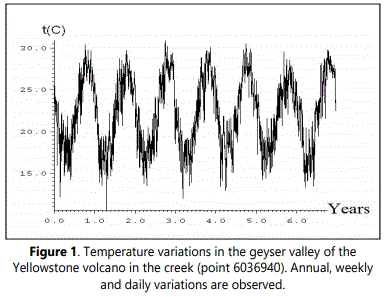
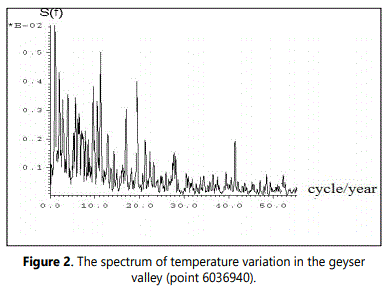
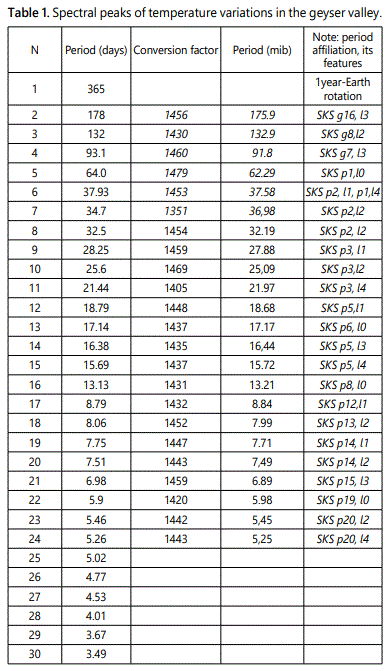
Abstract
The data in table 1 contain, up to the 3-4th digit, a multiple relationship of the obtained peaks of temperature variations with the natural oscillations of the Sun (SCS), while the conversion factor lies in the range of 1470-1420 relative to the recorded SCS. Perhaps these are usually ultra-low-frequency SCS, which are usually not registered by the known equipment and are not provided for by the theory of the Sun. Features of the result require special research. It is likely that such sub harmonics that are far from relevant correspond to low-frequency resonant structures of the geological environment.
Next, a recording of the KP indices was obtained (duration 75 days) and temperature data in the geyser valley near the stream (point 6036940) also for 75 days (UT time) as well as CR indices. Further, temperature variations of the Cs137 sample were used over 72 days on July 21, 2017 and variations in the radioactivity of the Transbaikal uranium ore over the same time. Based on the data obtained, a correlation analysis was performed (Figures 3 and 4).
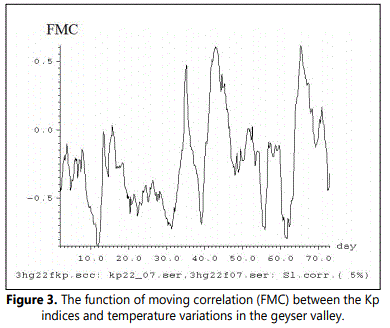
The maximum correlation coefficient (Figure 3) from K=-0.752 in a 5% window is -0.849 for 10 days to K=+0.613 for 44 days of the filtered function of water temperature variations (more than 30 independent points, significance P>0.99). Physically, such a significant correlation positive relationship means the higher the intensity of solar radiation-the higher the temperature in the stream. The connection of the same processes, but with negative correlation coefficients, is more difficult to interpret. It is necessary to remember the role of solar muons and neutrinos in heating the upper magma chamber of the volcano [3]. In cloudy or rainy weather, these processes may dominate. Further analysis of the data concerned the determination of FMC in the 9% window between the Cp indices and temperature variations of Cs 137 (Figure 4).
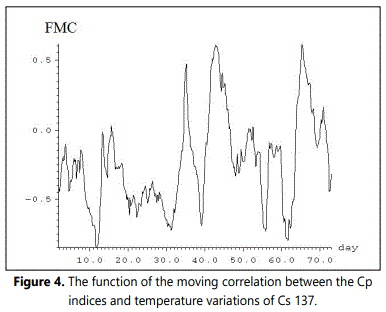
According to figure 4, there are significant correlation coefficients, both positive K=+0.65 at 10 and 30 days, and negative K=-0.5. Then FGC was obtained in a 9% window between the temperature variations of Cs 137 (radiometer on heat fluxes, figure 3) and the radioactivity variations of Baikal ore (standard radiometer, Figure 5).
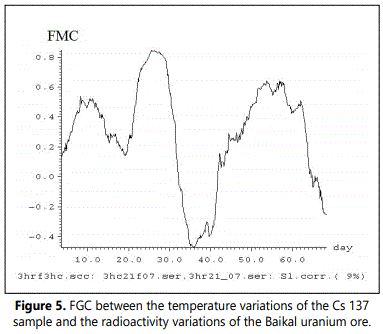
Next, significant correlation coefficients were obtained as positive, K=+0.85 at 20 and 30 days, and negative K=-0.45. Then, according to FGC, in a 9% window between variations of the Kp indices and variations in the radioactivity of the Baikal ore, significant correlation coefficients were obtained, both positive K=+0.65 at 30 days and negative K=-0.45 at 60 days. All these observable results prove the relationship of radioactive processes with solar Cr indices. The inter-correlation function (CVF) between the temperature variations of Cs137 and the radioactivity variations of Baikal uranium ore with 3-hour sampling indicates a shift between the processes of two days. It is very important to apply correlation analysis to the parameters of the geysers valley (Figure 6).
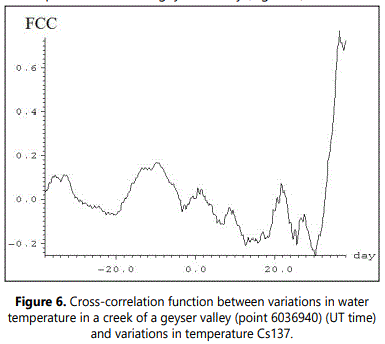
According to figure 6, there is a shift in the correlation maximum by 36.5 days relative to variations in the temperature of cesium 137. That is, the flux of solar neutrinos and muons almost simultaneously affects cesium 137 and the radioactive substances of the magma chambers of the supervolcano, but the thermal variations of magma and surrounding structures reach the surface and sources stream only after 36.5 days.
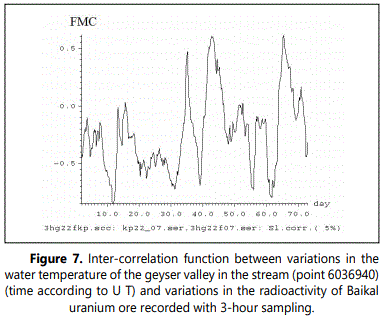
According to figure 7, a shift is also observed by the same 36.5 days, the maximum correlation of variations in water temperature relative to variations in activity of the Baikal ore. That is, the same delay mechanism acts due to the passage of the thermal variation of the distance of the magma chamberthe day surface. The discovered features of the thermal response to the solar neutrino flux were physically modeled (Figure 8).

Records of temperature variations of Сs137 and Baikal ore were obtained using EClerk-USB-2Pt-KI thermometers, the recording accuracy was 0.01С0. On these records of temperature variations, daily variations are observed due to thermal changes day-night including weekly. When processing the experimental results, these variations were filtered (removed).
A spectrum of the inter-correlation function was also obtained between the variations of the Kp indices and the temperature variations in the creek caldera of the volcano (point 6036940), a peak at 28.4 days is highlighted in the spectrum. The same peak is distinguished in the spectrum of the inter-correlation function between variations in the temperature of cesium and uranium ore in the laboratory.
The sliding correlation functions (10% window) were obtained between the temperature variations in the creek caldera of the volcano (point 6036940) and the temperature variations of cesium and ore. The sliding correlation functions (5% window) between the temperature variations in the creek caldera stream (point 6036940) and the cesium and ore temperature variations are presented. An increase in the correlation coefficient occurs with a decrease in the correlation window from 10% to 5%. The significance of the correlation is P>0.99 according to the Student criterion in all cases.
Elbrus
The fine structure of the temperature fields in the rock mass was studied with precision thermometers that allowed temperature measurements with a sensitivity of ~0.005°C in the adit of the North Caucasus Geophysical Observatory of the Institute of Physics and Physics RAS, that is, in the Baksan Gorge at a distance of 4100 m from the mouth of the adit of the Baksan Neutrino Observatory (NNO) [4]. Such constant monitoring of the thermal field is similar to long-term observations in the caldera of the Yellowstone volcano. We previously showed: It is likely that the addition of temperature observations with the results of their statistical processing, with the data of other physical parameters of both the volcano and the astrophysical situation will be necessary not only to obtain new fundamental knowledge about the dynamics of the magmatic structures of the volcano, but also to assess the danger of an explosive volcanic eruption. External influences include, first of all, the Sun as a source of neutrino fluxes and muons, solar flares and other probable astrophysical factors (supernova explosions, cosmic rays, etc.). Considering that the state of the mountain structures of Elbrus is represented by variations of thermal fields [4], they were compared with temperature variations of laboratory radioactive sources (Moscow) and with a radiometer, that is, the role of the cosmogony factor, supplemented by a correlation estimate by the KP index, was estimated. In Moscow, the simplest radiometer using heat fluxes was used [5].
Since December 20, almost simultaneous observations of temperature variations in the mountain massif of the BNO adit, temperature variations in the IPZ RAS and radioactivity variations of the Baikal uranium ore in the IPZ RAS (Figure 9-11) were carried out. According to figures 9-11, a statistical analysis was performed (Figures 12-14).
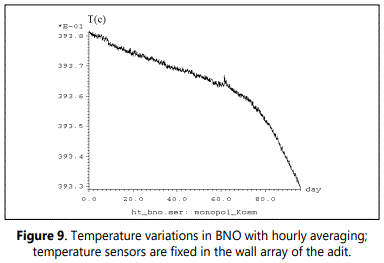
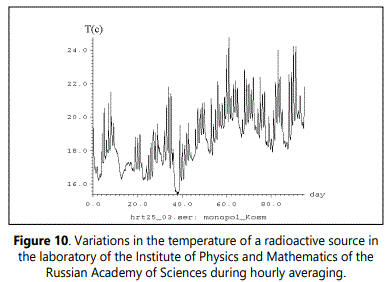
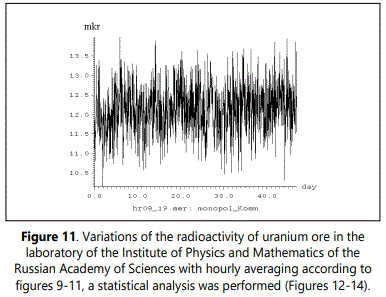
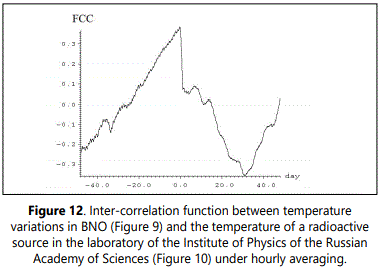
The observed fact of a high significant correlation K=0.85 at a shift of 30 days is noteworthy, indicating the high role of the radioactive elements of the Elbrus volcano (volcanic cone, magmatic chambers).
Figure 14 shows the inter-correlation function between the variations in the radioactivity of uranium ore in the IPZ RAS during hourly averaging (Figure 11) and the temperature variation of the radioactive source in the IPZ RAS during hourly averaging (Figure 10). In figure 14, a significant negative (K=-0.4) correlation is observed at zero. Next, we studied the sliding temperature correlation of both studied processes (Figure 15).
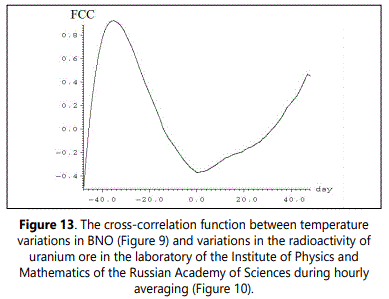
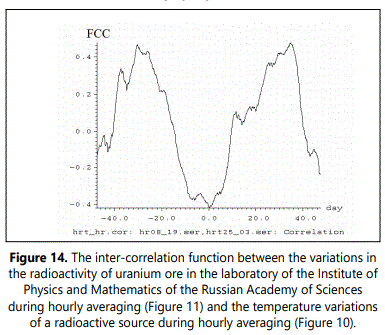
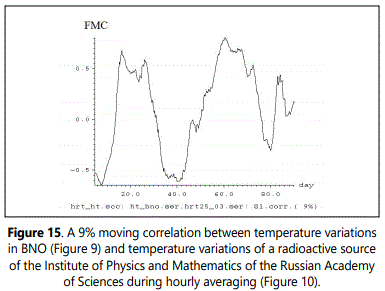
Abstract
It is noteworthy that the range of correlation coefficient variations from K=-0.6 to K=+0.8 (with a recording time of 60 days).
Also, spectra of temperature variations in BNO and temperature variations of a radioactive source at the Institute of Physics of the Russian Academy of Sciences were obtained with hourly averaging (Figures 16 and 17).
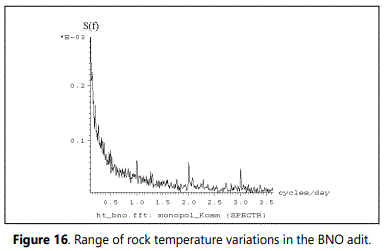

In the spectrum of figure 16, diurnal, semidiurnal, and 8-hour peaks are observed; in the spectrum of figure 17, a weekly peak is also observed. Note that according to recent studies, the rotation period of the inner core of the Sun lies within 6-8 days.
Solar flare and activation of super volcano
Sometimes this connection was assumed, but without good reason. This was first perceived as reality after observing a solar flare with a neutrino telescope [6]. According to observational data (Figure 18), the flare is accompanied by a powerful ejection of solar neutrinos, comparable to observable background. Peak (b) in figure 18 in time corresponds exactly to the peak of the solar flare recorded on standard equipment.
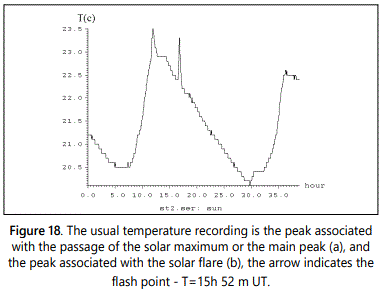
The recorded flare is insignificant, and this means that solar flares that are quite powerful according to the catalog are accompanied by incomparably large neutrino emissions. Such a pulsed energy effect on the magma chambers of a super volcano can lead to activation and subsequent explosive eruption. Consider the laws or causes of solar neutrino emission as components of a solar flare. The outbreak appears against the background of the activation of a certain part of the Sun; in large outbreaks, 1030–1032 erg of energy is observed (eruption of the volcano 1027 erg) [7]. It is accepted that a flash does not significantly change the energy balance, but noticeably changes the radiation hardness, including the neutrino component, according to Khavroshkin and Tsyplakov, [6]. According to Siberian Branch of the Academy of Sciences of the USSR [7], when the Sun activates, extensive flash fields are observed, that is, the neutrino exit from significant areas of surface or near-surface structures and/or (volumes) of the central zone of the Sun is emitted in the form of isolated powerful flows of a limited diameter and not strictly directed along the normal (radius) Of the sun). Therefore, existing estimates of the real flux without these features need to be reviewed, as well as the severity of the problem of neutrino shortage (by no means questioning the effect of neutrino oscillations) [8]. Taking into account the neutrino of the flare stream, the total stream corresponds to the theoretical model of the Sun with a nuclear energy source. Also, the anti correlation of the neutrino flux and solar activity should be recognized as non-existent, just an additional part of the supposed flux is taken by solar flares (their neutrino fluxes are still not taken into account, they should be attributed to “lost” neutrinos [8]). Thus, it is necessary to recognize the standard model of the Sun [8], and the known “lost” neutrinos exist as a component of solar flares [6]. The latter makes it possible to evaluate the possible contribution of flares to the activation of super volcanoes.
To determine the relationship with solar data, Kp index data were obtained from December 15, 2018, until March 31, 2019 (Figure 19).
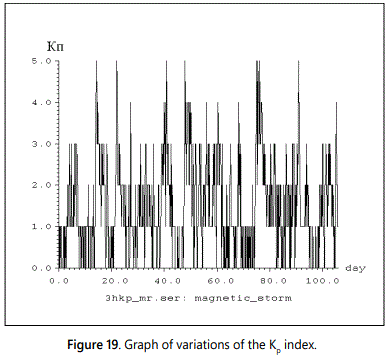
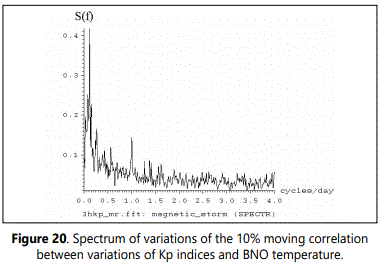
Surprising is the range of significant correlations from (K=-0.6 to +0.65) indices of the Sun. In the spectrum of KP indices, the rotation frequencies of the Sun 28.5 days and the daily rotation of the Earth are distinguished.
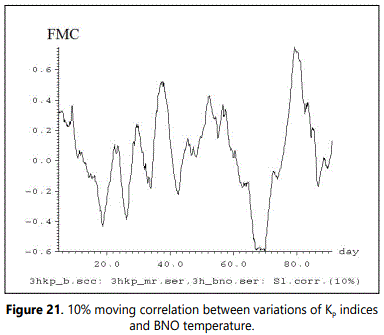
Surprising is the range of significant correlations from (K=-0.6 to +0.65).
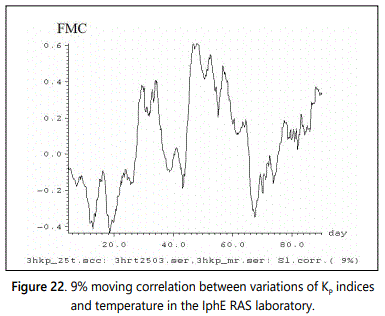
The range of significant correlations from (KP=-0.4 to +0.6) is surprising.
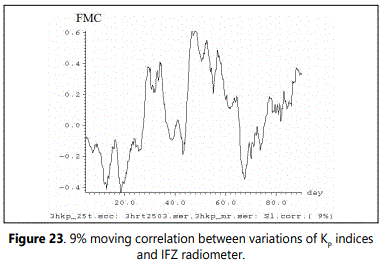
Abstract
The correlation is also significant at the level of P=0.009. Next, we obtained the spectra of inter-correlation functions between the solar KP indices and temperature observations in BNO and IPF.
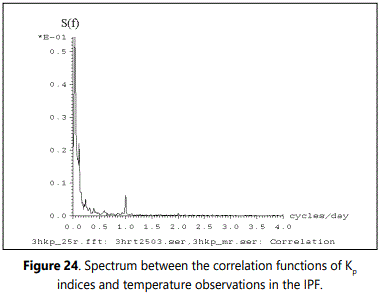
In addition to the frequencies associated with the rotation of the Sun and the Earth, weekly periodicity is observed.
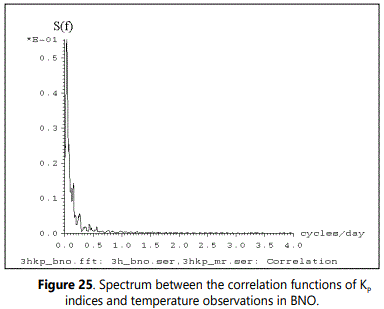
Strange as it may seem, there is no daily component in the spectrum.
Sun and the Earth, periodicities of T=8.5 days and 3.5 days are observed findings.
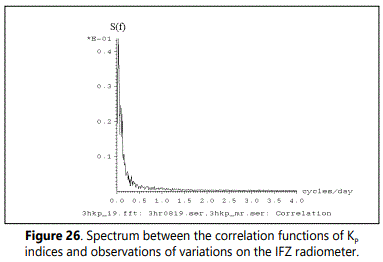
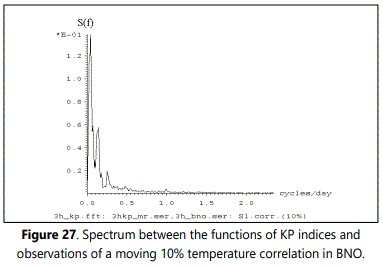
Findings
Super volcanoes during the activation process tend to show periodization in the manifestation of their main parameters, especially in the case of an explosive eruption approaching, which makes it possible to synchronize their thermodynamic state. A significant, if not basic, role in these processes is played by the astrophysical factor: the state of the Sun, its cyclical nature, and flare activity; cosmic ray level, supernova explosions. It is necessary to take into account local factors - lunar - solar tides, global and local seismicity.
In conclusion, the authors express deep gratitude to D.V. Likhodeev, candidate of physical and mathematical sciences for the materials provided by BNO.
References
- Khavroshkin OB, Tsyplakov VV. Sun, Earth, radioactive ore: common periodicity. Natural Science. 2013; 5(9): 1001-1005. doi: 10.4236/ns.2013.59123
- Khavroshkin OB, Tsyplakov VV. Yellowstone`s Volcano and Sun: Fragments Selected Works. Journal of Geology and Geoscience. 2017; 1(1): 5-16.
- Likhodeev DV, Gravirov VV, Kislov KV. Precision differential thermometers for studying thermal processes on the basis of the North Caucasus Geophysical Observatory. Seismic Instruments. 2018; 97(1): 15-24.
- Khavroshkin OB, Tsyplakov VV. Neutrino Telescope: Problems and Solution. SF J Astrophysics. 2018; 1(4): 1-11.
- Bahcall JN, Ulrich RK. Solar models, neutrino experiments, and helioseismology. Rev Mod Phys. 1988; 60(2): 297. doi: 10.1103/RevModPhys.60.297


